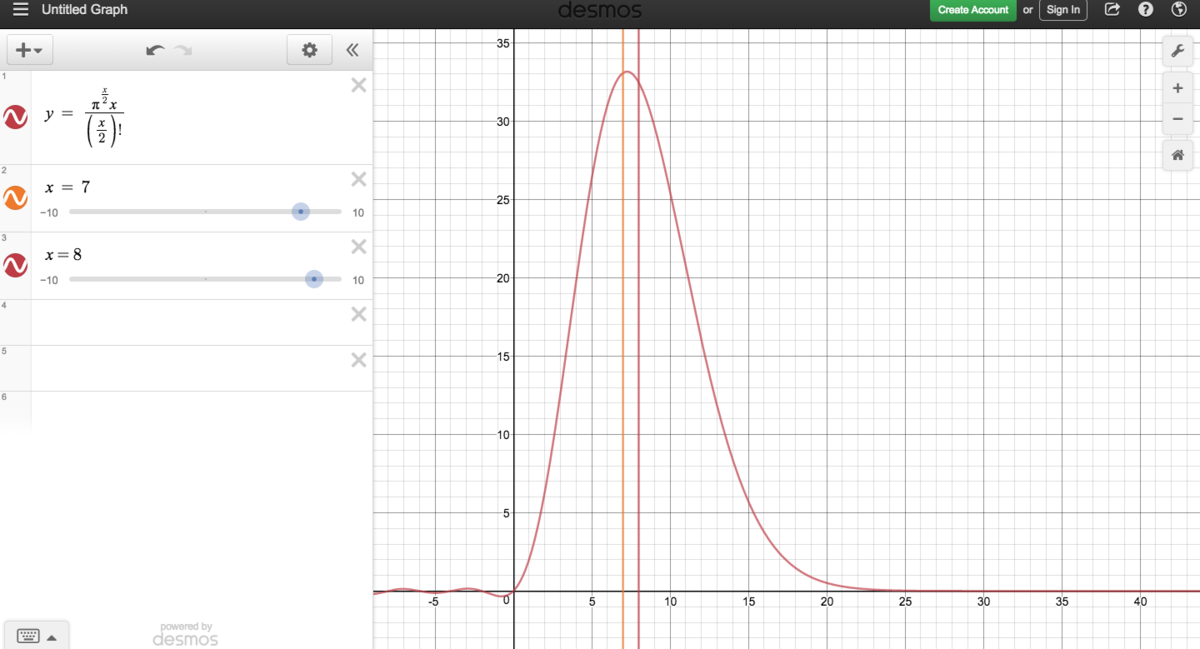Unit Spheres in N dimensions
The circumference of a unit circle is 2 π . The surface of a unit sphere is 4 π .
Consider now the generalization of a unit sphere in N dimensions: find the integer N which maximizes its surface.
This section requires Javascript.
You are seeing this because something didn't load right. We suggest you, (a) try
refreshing the page, (b) enabling javascript if it is disabled on your browser and,
finally, (c)
loading the
non-javascript version of this page
. We're sorry about the hassle.
2 solutions
i am going to derive the formula for surface area of a nth dimension sphere. but if we were to recursively integrate to find the surface area, we would have to integrate with respect to
d
s
, which would be messy. so instead first the volume is going to be found. notice that the volume would be
V
(
n
,
r
)
=
f
n
r
n
, so we are only going to find
f
n
and add on the radius part later. we start of by the equation
x
1
2
+
x
2
2
+
.
.
.
.
+
x
n
−
1
2
+
x
n
2
=
1
→
x
1
2
+
x
2
2
+
.
.
.
.
+
x
n
−
1
2
=
1
−
x
n
2
2
which implies that a nth dimensional sphere can be thought of as multiple (n-1) dimensional sphere with radius of the form
1
−
x
n
2
from 1 to -1. or that
f
n
+
1
=
∫
−
1
1
V
(
n
,
1
−
x
n
2
)
d
x
n
=
f
n
∫
−
1
1
(
1
−
x
n
2
)
n
/
2
d
x
n
we just need to find
∫
−
1
1
(
1
−
x
n
2
)
n
/
2
d
x
n
=
2
∫
0
1
(
1
−
x
n
2
)
n
/
2
d
x
n
=
:
u
=
x
n
2
∫
0
1
u
−
1
/
2
(
1
−
u
)
n
/
2
d
u
=
β
(
1
/
2
,
n
/
2
+
1
)
=
Γ
(
(
n
+
1
)
/
2
+
1
)
π
Γ
(
n
/
2
+
1
)
now obviously using recursion:
f
n
+
1
=
Γ
(
(
n
+
1
)
/
2
+
1
)
π
Γ
(
n
/
2
+
1
)
f
n
=
Γ
(
(
n
+
1
)
/
2
+
1
)
π
Γ
(
n
/
2
+
1
)
Γ
(
n
/
2
+
1
)
π
Γ
(
(
n
−
1
)
/
2
+
1
)
f
n
−
1
=
Γ
(
(
n
+
1
)
/
2
+
1
)
π
Γ
(
n
/
2
+
1
)
Γ
(
n
/
2
+
1
)
π
Γ
(
(
n
−
1
)
/
2
+
1
)
.
.
.
.
.
Γ
(
1
/
2
+
1
)
π
Γ
(
1
)
f
1
notice the telescope. we are left with (using
f
1
=
2
)
f
n
+
1
=
Γ
(
(
n
+
1
)
/
2
+
1
)
2
(
π
)
n
+
1
→
f
n
=
Γ
(
n
/
2
+
1
)
2
(
π
)
n
so we have
V
(
n
,
r
)
=
Γ
(
n
/
2
+
1
)
2
(
π
)
n
r
n
→
S
(
n
.
r
)
=
∂
r
∂
V
(
n
,
r
)
=
Γ
(
n
/
2
+
1
)
2
n
(
π
)
n
r
n
−
1
so for a unit nth sphere
S
n
=
Γ
(
n
/
2
+
1
)
2
n
(
π
)
n
. it cannot be maximized analytically ,at least to the best of my skills so i graphed it.
 it can be seen that among the two contenders of 7 and 8, 7 yields a higher answer, so the number of dimensions that would maximize the surface area of an unit NTHsphere is
7
it can be seen that among the two contenders of 7 and 8, 7 yields a higher answer, so the number of dimensions that would maximize the surface area of an unit NTHsphere is
7
The surface S N of a sphere of radius r in N dimensions is given by S N = Ω ( N ) r N − 1 , where Ω ( N ) = Γ ( 2 N ) 2 π 2 N is the solid angle in N dimensions. Ω ( N ) is therefore the surface of an N dimensional unit sphere. Since the Euler Gamma function Γ ( N ) grows to infinity faster than any exponential (as a matter of fact Γ ( n ) = ( n − 1 ) ! for any integer n ), we easily obtain that lim N → ∞ Ω N = 0 , which means that Ω ( N ) have at least one local maximum in ( 0 , ∞ ) . Evaluating numerically d N d Ω = 0 yields N m a x ≃ 7 . 2 5 7 , which approximated to the closest integer is 7.